"Every Who down in Whoville
liked Christmas a lot.
But the Grinch, who
lived just north of Whoville,
did not."
He stole all Who presents - he
took the Who trees.
He tried to make Christmas
disappear with the breeze.
But each Who down in Whoville,
the tall and the small,
Kept singing - and hopeful -
without presents at all....
Their joy touched old Grinch,
and thrice grew his heart
-
And
"himself" returned every
toy and plum tart!
"So welcome Christmas. Bring
your cheer.
Cheer to all Whos - far and
near.
Christmas Day is in our grasp
As long as we have hands to
clasp.
Just as long as we have we.
Welcome Christmas while we stand
Heart to heart and hand in hand"

(With thanks to
Dr. Seuss and Michelangelo)
The first plates were leaves. The first cups
were shells.
We've learned about this from legends and
tells.
One sunny
day - by hand and by luck -
A clay
vessel was formed by some handsome young
buck.
Whether
dropped in the fire or hardened by sun,
We can only
surmise as to how 'twas begun.
The ceramics
and glass below are 2011 acquisitions, & listed
chronologically by dating.
Click
on the images for more information.
|
|
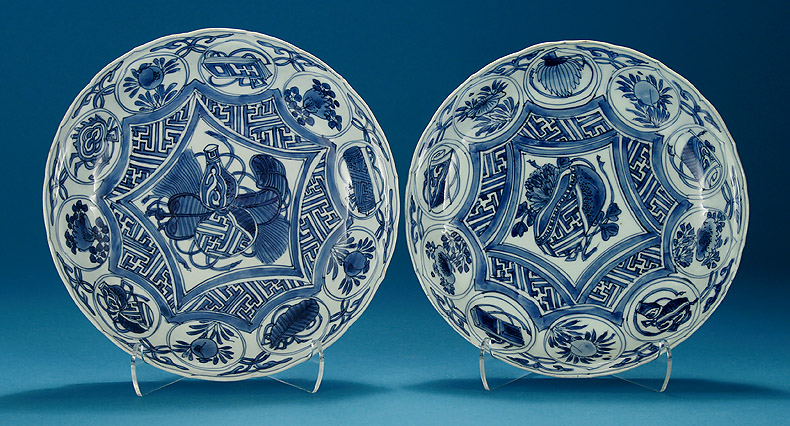 |
|
Associated Pair of Ming Kraak Dishes, Rinaldi Border Type VII
China, c1595-1615
Sold
|
Each with a slightly flared and foliated edge and rounded cavetto, painted
in nicely shaded underglaze blue with central bracketed
auspicious symbols (the gourd of Li Tieguai
– protecting children from smallpox, and enhancing longevity)
Ref : See Rinaldi, p. 109-10; for a similar dish from Rinaldi’s personal
collection, see Pl. 104
Kraak
porcelains are so named after the Dutch
capture of two Portuguese vessels (in 1602 & 1604)
called
"carracks" - these vessels
containing thousands of pieces of Chinese porcelain. The ships and
porcelains were renamed by the Dutch,
"Kraak".
This capture simultaneously set forth a mania for Chinese porcelains in all
of Europe.
|
|
|
|
|
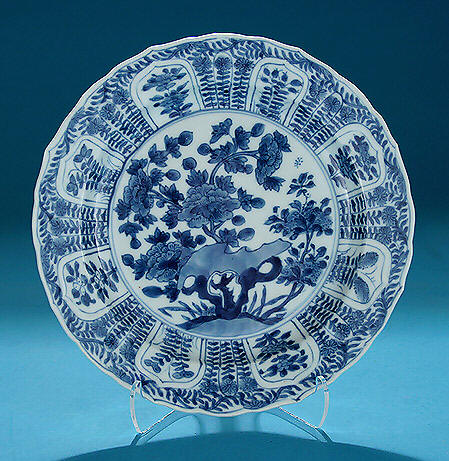 |
|
Kangxi Blue & White Barbed & Molded Dish
China, c1700-1710
|
The verso painted with a most unusual
decoration of border of petals and precious objects
surrounding a
fantasy mark (possibly a lotus) within concentric circles.
In 1662,
Emperor Kangxi
of the new Manchu Qing (Ch'ing) dynasty assumed the throne. Despite
the kilns being destroyed twice by the outgoing Ming Dynasty,
his rule produced from 1682-1722 the
finest blue and white ever
produced, both technically and visually.
The ceramic became quite thin, with a glassy glaze, the blues even more like
sapphires beneath it. Painting was free and precise at the same time.
To protect his wares from continued Ming destruction, he introduced a
marking we still see copied today - that of two concentric circled.
The circles often contained a
fantasy mark.
Sold
|
|
|
|
 |
|
George II Engraved Baluster with Unusual Spiral Tear & Folded Foot
England, c1730
|
Heavy and light baluster wine glasses
were the first forms of the early 18th century.
Decoration is rare, and when seen usually reflects the use, as grapes and vines above in this light
baluster wine. In
addition, the stem carries a seemingly
intentional tear of spiral
formation. This is not a
lighter airtwist - that form coming from about 1750 as a result of a
1745 excise tax on glass "by weight" - supposedly to make the glass
blower re-use some of their shards & use less wood in the firing -
leaving the wood for boat-building. The tax caused glass blowers
to seek ways to lighten glass introducing the airtwist stem about
1750.
Sold
|
|
|
|
|
|
|
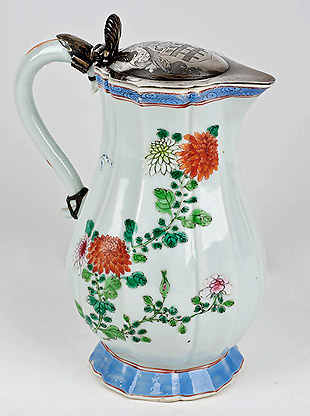 |
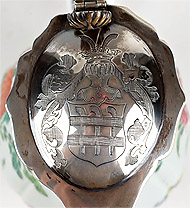 |
|
Chinese Export Famille Rose
Silver-Mounted Jug
Qianlong, c1750
The molded jug bearing a
Continental
Coat of Arms
to the lid
9" High
Sold |
|
|
|
|
|
|
 |
|
Bow Octagonal Two Quail Deep Dish in the Arita Manner
England, c1755
|
Molded and shaped in the Arita manner, of heavy weight and having
a molded rim and "corners",
the
verso
marked with an iron red 2
The Two Quail, or Partridge pattern,
is derived from a Japanese Kakiemon original.
The name
“Kakiemon” was bestowed upon
Japanese potter Sakaida (1596-1666), who presented the emperor with a particularly arresting design of two persimmons.
This pleased the emperor so much that he gave Sakaida the name
“Kakeimon” – meaning “persimmon
man”. Kakiemon designs are
usually very elegant and spare, and of asymmetrical balance
Sold
|
|
|
|
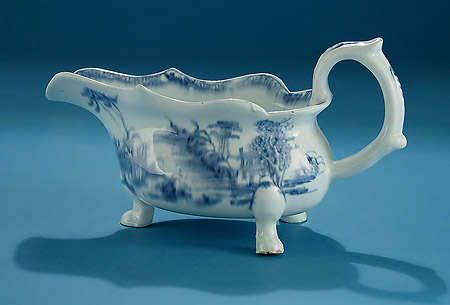 |
|
Bow Porcelain Oval Sauce Boat on Three Paw Feet
England, c1755
|
An early
example painted in blue and white in the "Desirable Residence" pattern,
the
verso with a painter's mark
In the
1750's porcelain was in its infancy in England. The
paw feet
(as seen above) are a reflection of silver shapes, and of Chinese
porcelains. These raised feet were used on some of the earliest wares,
including candlesticks and sauceboats.
I find their use to be among the
most charming - and probably the most fragile - of all Bow and early English
porcelains.
|
|
|
|
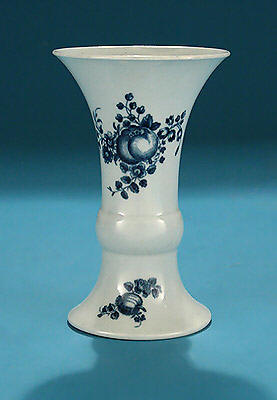 |
|
First Period Worcester Gu Beaker
Vase
England, c1765
|
"Fruit Sprays" pattern with Crescent mark verso, 6" High
The gu form dates
to Neolithic ceramics in the lower and middle basins of the
Yangxi River in China.
A 6.25” ritual beaker from the 11th
- 13th century BC (Shang Dynasty), is spoken of as having “a
bulging waist with flanges, a feature also noted on
contemporary bronze vessels” (He Li, Chinese Ceramics)
|
Sold
|
|
|
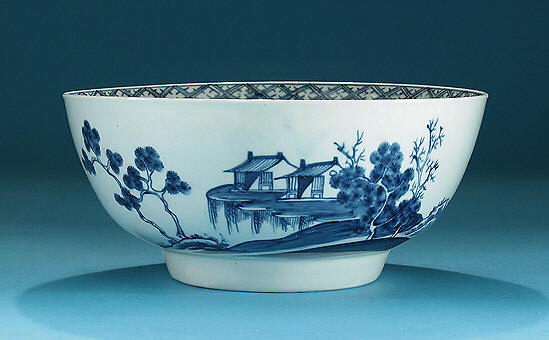 |
|
First Period Worcester Punch Bowl, The Precipice
England, c1765-75
|
The Precipice pattern
depicts a bridge separated by two pavilions, one on a high precipice,
the interior depicting a further pavilion
between two precipices and Wan Li style diapering
This punch bowl measures
4" high x 8.75" wide.
These large bowls are not plentiful among early
Worcester wares.
Sold |
|
|
|
|
|
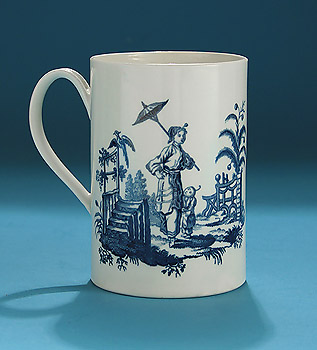
|
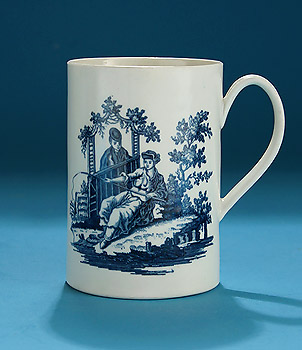
|
|
Large First Period Worcester Mug
(Pillement)
England, c1770
|
'La Promenade Chinoise'
and
'La Peche',
blue crescent mark
The two prints always occur together and
therefore should be regarded as a single pattern.
The designs were first
published in ‘Le Livres Chinoise’ after designs by
Jean Pillement,
but engraved by Canot in 1758. The adapted form used at Worcester by
Hancock also appears in the ‘Ladies Amusement’ published by Robert Sayer in
1760.
Sold |
|
|
|
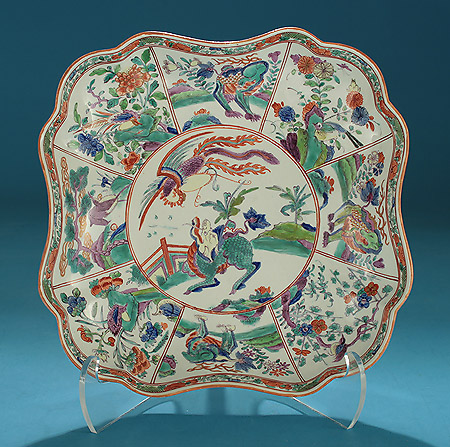 |
|
First Period Worcester Dessert Dish,
Bishop Sumner Pattern
England, c1770-75
|
After a Kangxi famille verte original, square shaped dish
depicts a central roundel of a mythical kylin
below a
flying dragon in a fenced landscape, surrounded by eight panels of
flowers, birds and further mythical animals -
no two panels being alike.
It is marked verso by a gold
crescent mark
Although this pattern originates from the 18th
century, it apparently acquired its name in the 19th century –
probably from one of the two Bishop Sumner’s (John Sumner,
Archbishop of Canterbury, or Charles Sumner, Bishop of Winchester).
Sold |
|
|
|
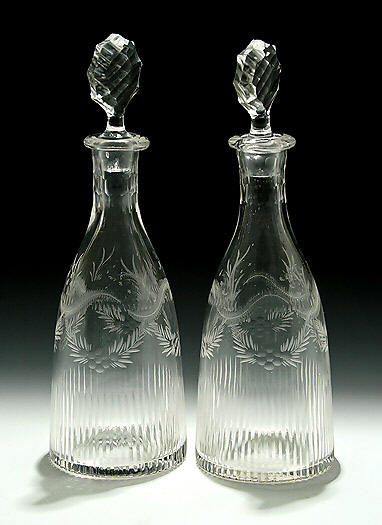 |
|
Fine Pair of George III Engraved Tapering Decanters
England, c1780
|
The bodies
with floral and swag engraving above berry clusters, narrow upright flutes
at the base,
the ovoid stoppers with
facetted flat surfaces and edges
Tapering decanters are
the earliest forms of stoppered decanters in England. Facet
cutting was introduced
after an excise tax on glass - particularly on colored enamels in
drinking glasses - was imposed, following the war with the
Americas. Popular at the time were Adam brothers chandeliers with
facet cut prisms - which proved to be very decorative and highly reflective of light. You see this decorative form of illumination
in the facet cut stoppers above.
Sold |
|
|
|
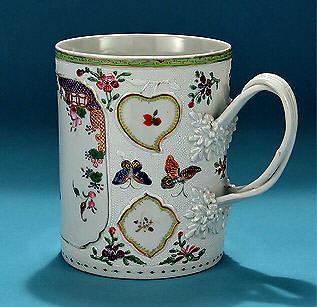 |
|
Chinese Export Famille Rose Mug
Qianlong,
China, c1780
|
|
A large well painted Chinese
export mug,
molded with raised panels,
insects and flora,
and
painted in overglaze famille
rose enamels reserved on a
"chicken-skin" ground,
the applied interlaced
handles issuing from molded
acanthus leaves
5.25" High x 6" Wide
Sold |
|
|
|
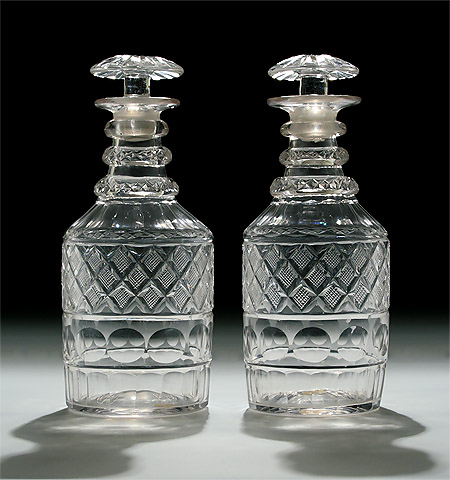
Pair of Regency Cut Barrel
Decanters
England, c1815-20
|
Each barrel shaped decanter with
three applied neck rings
and slice-cut shoulders over a fine
diamond-cut panel
and vertically fluted base;
cut mushroom stoppers;
good footrim wear
This form of decanter was popular
from c1811, when the future George
IV became Prince Regent, until c1840
and the entry into the Victorian
period of taste. Later 19th
and 20th century copies had molded
rather than applied neck rings, and
the diamond and slice cutting was as
finely wrought.
Sold |
|
|
|
For more ceramics and glassware,
please see :
Ceramics Page :
https://www.mfordcreech.com/ceramics.html
Glassware Page :
https://www.mfordcreech.com/glassware.html
Also please see :
Christmas Catalog - Part II / Silver
Christmas Catalog - Part III / Fine Art
Christmas Catalog 2011 - Part IV
|
|
Should you
have further
questions,
please
email, call
or come to
visit.
Millicent
Ford Creech
901-761-1163
(gallery) /
901-827-4668
(cell)
581 S.
PERKINS ROAD
/ LAURELWOOD
COLLECTION /
MEMPHIS, TN
38117
Hours :
Wed.-Sat.
11-6, or by
appointment
Complimentary
Gift
Wrapping
mfcreech@bellsouth.net
or
mfordcreech@gmail.com
www.mfordcreech.com
To receive
our periodic
email
catalogs,
please click
here.
American Express, Mastercard, Visa and Discover accepted
|
|
|
Home
Accessories
Ceramics
Early Asian Ceramics
Fine Art
Furniture
Glassware
Silver |
|
Christmas Catalog - Part I /
Ceramics & Glass
 
© Images and some text are copyrighted by this gallery.
Please reproduce with our specific written permission only.
|
|
|
|
|
|